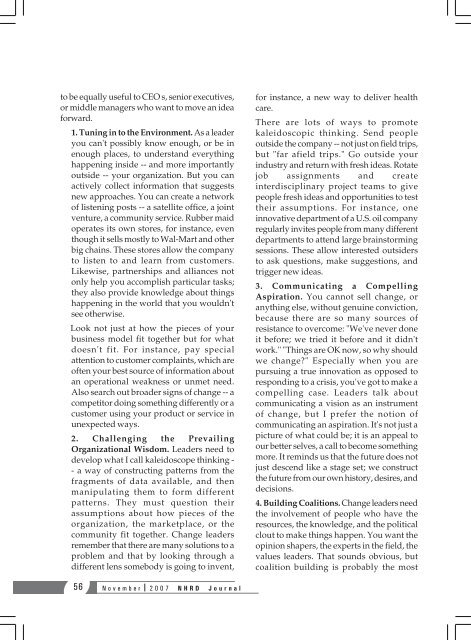NHRD Journal - National HRD Network
NHRD Journal - National HRD Network
NHRD Journal - National HRD Network
Create successful ePaper yourself
Turn your PDF publications into a flip-book with our unique Google optimized e-Paper software.
to be equally useful to CEO s, senior executives,<br />
or middle managers who want to move an idea<br />
forward.<br />
1. Tuning in to the Environment. As a leader<br />
you can't possibly know enough, or be in<br />
enough places, to understand everything<br />
happening inside -- and more importantly<br />
outside -- your organization. But you can<br />
actively collect information that suggests<br />
new approaches. You can create a network<br />
of listening posts -- a satellite office, a joint<br />
venture, a community service. Rubber maid<br />
operates its own stores, for instance, even<br />
though it sells mostly to Wal-Mart and other<br />
big chains. These stores allow the company<br />
to listen to and learn from customers.<br />
Likewise, partnerships and alliances not<br />
only help you accomplish particular tasks;<br />
they also provide knowledge about things<br />
happening in the world that you wouldn't<br />
see otherwise.<br />
Look not just at how the pieces of your<br />
business model fit together but for what<br />
doesn't fit. For instance, pay special<br />
attention to customer complaints, which are<br />
often your best source of information about<br />
an operational weakness or unmet need.<br />
Also search out broader signs of change -- a<br />
competitor doing something differently or a<br />
customer using your product or service in<br />
unexpected ways.<br />
2. Challenging the Prevailing<br />
Organizational Wisdom. Leaders need to<br />
develop what I call kaleidoscope thinking -<br />
- a way of constructing patterns from the<br />
fragments of data available, and then<br />
manipulating them to form different<br />
patterns. They must question their<br />
assumptions about how pieces of the<br />
organization, the marketplace, or the<br />
community fit together. Change leaders<br />
remember that there are many solutions to a<br />
problem and that by looking through a<br />
different lens somebody is going to invent,<br />
for instance, a new way to deliver health<br />
care.<br />
There are lots of ways to promote<br />
kaleidoscopic thinking. Send people<br />
outside the company -- not just on field trips,<br />
but "far afield trips." Go outside your<br />
industry and return with fresh ideas. Rotate<br />
job assignments and create<br />
interdisciplinary project teams to give<br />
people fresh ideas and opportunities to test<br />
their assumptions. For instance, one<br />
innovative department of a U.S. oil company<br />
regularly invites people from many different<br />
departments to attend large brainstorming<br />
sessions. These allow interested outsiders<br />
to ask questions, make suggestions, and<br />
trigger new ideas.<br />
3. Communicating a Compelling<br />
Aspiration. You cannot sell change, or<br />
anything else, without genuine conviction,<br />
because there are so many sources of<br />
resistance to overcome: "We've never done<br />
it before; we tried it before and it didn't<br />
work." "Things are OK now, so why should<br />
we change?" Especially when you are<br />
pursuing a true innovation as opposed to<br />
responding to a crisis, you've got to make a<br />
compelling case. Leaders talk about<br />
communicating a vision as an instrument<br />
of change, but I prefer the notion of<br />
communicating an aspiration. It's not just a<br />
picture of what could be; it is an appeal to<br />
our better selves, a call to become something<br />
more. It reminds us that the future does not<br />
just descend like a stage set; we construct<br />
the future from our own history, desires, and<br />
decisions.<br />
4. Building Coalitions. Change leaders need<br />
the involvement of people who have the<br />
resources, the knowledge, and the political<br />
clout to make things happen. You want the<br />
opinion shapers, the experts in the field, the<br />
values leaders. That sounds obvious, but<br />
coalition building is probably the most<br />
56<br />
November 2007 <strong>N<strong>HRD</strong></strong> <strong>Journal</strong>
















